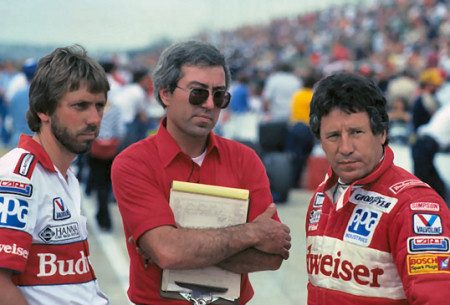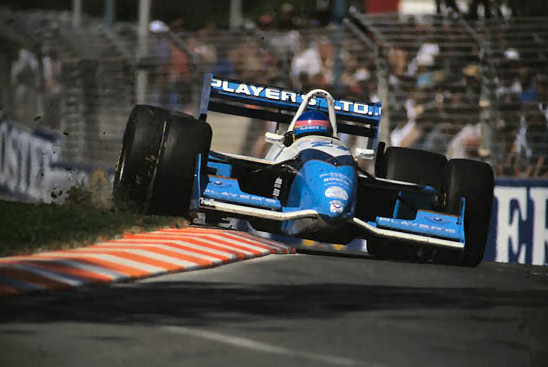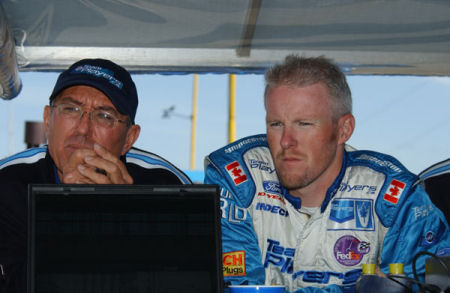The Way It is/ Oh, for another day!
by Gordon Kirby Many people in racing spend quite a bit of time looking back these days and it's remarkable how many say that for a short period of time from the late eighties through the nineties CART's PPG Indy Car World Series was the world's best racing series. It enjoyed plenty of great drivers and teams as well as three or four competing chassis builders and four engine manufacturers in Mercedes-Benz, Ford/Cosworth, Honda and Toyota, and was closely-fought and unpredictable, everything a big-time racing series should be.
Many people in racing spend quite a bit of time looking back these days and it's remarkable how many say that for a short period of time from the late eighties through the nineties CART's PPG Indy Car World Series was the world's best racing series. It enjoyed plenty of great drivers and teams as well as three or four competing chassis builders and four engine manufacturers in Mercedes-Benz, Ford/Cosworth, Honda and Toyota, and was closely-fought and unpredictable, everything a big-time racing series should be.
Many of us enjoyed watching CART's growth and we hoped and believed it would get better, rather than worse. In recent years fans and participants from across North America and around the world from F1 to NASCAR have remarked that we lived through a great epoch in the sport's history without really appreciating it.
"We lived through a golden age," Mario Andretti said recently. "We never realized how good it was at the time."
Tony Cicale is one of America's most respected development and race engineers. Cicale was Andretti's race engineer at Newman/Haas from 1983-'85 and again in 1988, '90 and '91. Cicale won the 1984 CART championship with Andretti, the 1995 CART title and Indy 500 with Jacques Villeneuve, and the 2003 Champ Car title with Paul Tracy. For both Villeneuve and Tracy, Cicale was much more than an engineer. He was also a tutor and mentor. These days Cicale is a reluctant retiree who enjoys wind-surfing off Long Island, NY, and Florida's Gulf coast.

© Paul Webb
Indeed, whether by design or happenstance, CART brought together the disparate and often argumentative worlds of American oval and road racing to create a series with great appeal to many people. It had its own clear identity and was also, in some minds at least, an alternative to Formula One. Indeed, for a few years in the mid-nineties Bernie Ecclestone grew more and more worried about CART's growing worldwide TV audience.
"When you're involved in something you always think it's better than what it ultimately is," Cicale adds. "But I thought it was so unique going to all those different types of circuits. You had the superspeedways--Indianapolis, Michigan, Pocono and later Fontana--and you had the street circuits like Long Beach, Vancouver and Toronto, and road circuits like Elkhart Lake, Laguna Seca and Mid-Ohio, plus the different variety of short ovals from Milwaukee to Sanair. It was really unique and an incredibly strong period in American racing."
Cicale spent more than thirty years in the sport, first as a driver and Can-Am car builder, then as an Indy car engineer with Newman/Haas, Patrick Racing, Porsche's short-lived Indy car team, Galles/Kraco, Players/Forsythe, Team Kool Green and Andretti-Green. Cicale is a rigorous engineering disciplinarian and a student of the much more nebulous art of race engineering. He also has a quiet, dry sense of humor and occasionally lets his sardonic wit fly.
"It doesn't even come close today," Cicale remarks. "I try to watch the IRL races and I can't. They're just so terrible. I watched the races this year, but I can't think of one that stood out as an even acceptable race. It has very little meaning to me, which is sad. From the start I thought the whole IRL business was ridiculous and it's very sad to see the results of all that power squabbling and politics. It was a dreadful period for racing."
History is filled with stories about things evolving or dying. So too is human history rich in epic stories of family squabbles as the wealth-earning generation passes on the family fortune to following generations. Sometimes an even more powerful generation takes the family and its fortune to even greater heights. But almost inevitably a generation or two arrives riven by a preening kind of fecklessness and in their hands the fortune and power base dwindles, taken over in the end by lawyers and managers.
So too, did Tony George's attempt to change the course of history stumble and fail. The sad result is very different from the vision originally foisted on the public and swallowed by some in the media. After fifteen years of bitter squabbling Tony George's failed revolution, aimed at taking control of Indy car racing from CART's team owners, has been a calamitous failure, ending with a barely audible whimper last June when George was slapped on the wrist and dethroned by his mother and three sisters.
American open-wheel racing's sad decline has reduced and diluted not just CART's quarter-century but the entire hundred-year history of Indy car racing. Today, as we all know, NASCAR defines automobile racing in America while Formula One dominates the international stage. Few contemporary race fans know anything about the great Indy car heroes of the past like Jimmy Murphy, Frank Lockhart, Wilbur Shaw, Rex Mays, Bill Vukovich, Jimmy Bryan, A.J. Foyt, Parnelli Jones, Johnny Rutherford or the Unser brothers. Thanks to Tony George's bumbling the legacies of these legends and CART's greatest drivers have been greatly diminished across America and around the world and Indy car racing has devolved into a highly restricted spec car category equipped with a foreign chassis and engine and little or no aesthetic or emotional appeal.

© Paul Webb
"It's sad for the people who've been through it," Cicale observes. "It's sad for me because you look back and you always think there is some importance in what you do. There probably isn't anywhere near as much importance as you would like there to be. But ultimately, you would like to say, I was part of that and it was important at the time. Had it grown to something that was good and sustainable then you would have felt that the time and effort that you put in was of importance and had value, that you weren't just wasting your time for ten, fifteen or twenty years doing this thing that just benefitted you and nobody else.
"If it had continued on and grown and been important to a large number of people and become a big part of the economy, what you did ten and fifteen and twenty years ago would hold a little more reverance. But because it turned out the way it has, I almost feel it was a waste of time to get involved in it."
Cicale says it's more a matter of self-respect than public recognition.
"It's not so much the respect from other people," he remarks. "It's more of a personal respect. I spent twenty years of my life and committed myself to Indy car racing in the hopes that it would become something important for a lot of people and a lot of fans, that people would get excited about it and feel emotional or passionate about it. As you're involved in the sport and go through it, those are the positive things. You hope it leads to something that ultimately becomes important for more than one or two people. And when it turns out not to, you say to yourself, 'Gosh, maybe I shouldn't have been involved in motor racing at all.'
"I enjoyed it for more than twenty years and thought I contributed something important to the business side of it and to the history of it. But all that seems to have disappeared with the IRL. The whole memory of what CART and Champ Car was all about has been diluted into this IRL thing, which has nothing to do with it. I look at the IRL and I feel really bad that Champ Car dissolved the way it did because it makes the contributions that you thought were important seem meaningless or irrelevant."
Cicale is referring specifically to the considerable improvements in safety and car construction made by CART during the late eighties and early nineties. These things came about because Mario Andretti was an activist driver's representative on the CART board for a number of years and also because of an equally activist committee of engineers who vetted rule changes and made a steady series of improvements in the cars' footboxes and crash or crush structures. Cicale was part of an engineering consulting group that included John Ward, Lee Dykstra and Ian Reed, although CART's increasing internal political squabbles eventually resulted in Andretti and the engineers walking away from any more attempts to talk sense to the owners and their administrators.

© Paul Webb
"I quite honestly feel that we made so many important strides from the safety side well before any other group even thought about it," Cicale says. "Yet all the safety stuff we did has been totally obliterated. One of the things I'm most happy that I was involved with in Champ car racing is I thought I really contributed a lot to the safety side."
In the late seventies and early eighties many drivers, including Pancho Carter, Danny Ongais, Rick Mears and Derek Daly suffered serious leg, feet or pelvic injuries.
"When I first got involved in CART somebody was getting maimed or killed every weekend, or close to it," Cicale goes on. "There were some rules that a group of us developed that were really important. They were truly cutting edge and were timely and really about safety. They weren't pretending to be about safety. They were genuinely about safety and made a significant difference in a pretty short period of time.
"It's really sad that has disappeared from anybody's memory. I think those were some pretty important historical developments in racing. I think we saved a lot of people. Those accidents that Rick Mears and Derek Daly had in 1984 made me feel just sick to my stomach. We wanted something done to make it safer. It wasn't just a political or public relations move.
"I think we made a very big difference in a very short period of time. There were five or six drivers, including Derek Daly and Rick Mears, who came up after the fact and said they were really happy that you guys are doing this. 'It's really important,' they said, 'because we don't want other drivers to go through what we went through.' They said the cars were infinitely safer than they had been just a few years before.
"Ten years later, all these other organizations started developing or adopting things that Champ Car people did ten years previous to that. I think that's probably one of the saddest things because to me that was one of the most important things I contributed to. But because of CART's demise it has totally disappeared from the annals of history.

© Paul Webb
It's also important to realize that America has suffered from a series of sanctioning body suicides precipitated by complete failures at managing the technical rules or believing in technological development as an essential element of the sport. The SCCA was the first and perhaps most spectacular of these failures with the original Can-Am and Trans-Am series followed by Formula 5000 and 'new era' Can-Am. Then came IMSA's briefly booming GTP category which was also consigned to history's trashcan around the same time CART began to implode. As the owner of one of the country's more successful road racing tracks said to me last summer: "It's the worst-run sport in America." Against the odds, Cicale's old friend Mario Andretti hopes for a miracle.
"I hope the IRL series sponsorship really works for Izod and they get ten times what they're hoping to get out of it," Mario says. "But the thing that is so disheartening is they made the Izod announcement and nobody knew about it. It made Speed TV and Speed-Sport News, of course. But there was no CNN story, no AP story, nothing written about the announcement in our local papers here in Nazareth. The media just doesn't seem to care anymore. Nobody seems to know that Dario won the championship or that he's a great driver and a really good guy, too. And it's the same with Scott Dixon. Nobody seems to know, or care, who Scott Dixon is. It's sad."
In closing, I must emphasize that Andretti and Cicale are incurably forward-thinking, optimistic people. Their careers were driven by these principles and they took great pleasure in working together to solve problems.
"Tony was a very articulate individual who would go back after we had our debriefs and reason things out so that we had a plan for the following day," Mario says. "He had patience and total focus. He didn't worry about going to dinner. He didn't worry about what time it was. He worried about doing his homework and doing the job, and I loved that. He was a guy with a fresh approach to things and that gave me confidence and an even keel to push forward."
I'm sure Tony is enjoying himself this Christmas season with some wind-surfing in Florida's warm Gulf waters, a far more satisfying endeavor than watching IRL races. Meanwhile, the Indy car teams have formed a company, Delta Wing, to design and build a prototype of the new Indy car for 2012. Former Lola designer and current Ganassi employee Ben Bowlby is designing the new car for Delta Wing and there's no doubt that for Indy racing to rediscover its lost luster it needs a healthy shot of Cicale's spirit of pushing boundaries through rigorous scientific experimentation, unrelenting hard work and love of racing as a cauldron of new thinking.
In that spirit, I wish Bowlby and Delta Wing the best of luck and I wish all of you a Merry Christmas and Happy New Year. I'll be back on January 11th.
And I just received the latest 2009/2010 edition of Autocourse, now available from Motor Books and good bookstores everywhere like Paul Zimmermannís Motorsport Collector in Chicago. The latest Autocourse is as superbly-presented as ever and continues to set the standard as the most complete review of the yearís worldwide motor sport season. For any racing enthusiast thereís no better Christmas gift.
Auto Racing ~ Gordon Kirby
Copyright 2009 ~ All Rights Reserved
Copyright 2009 ~ All Rights Reserved
Top of Page